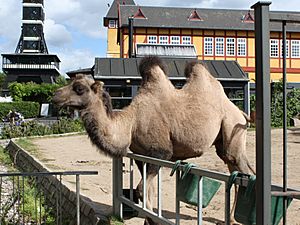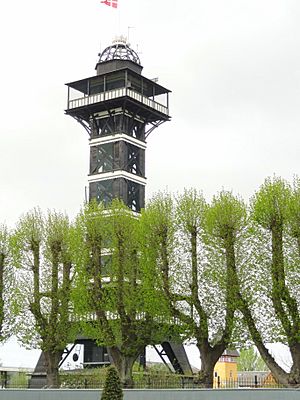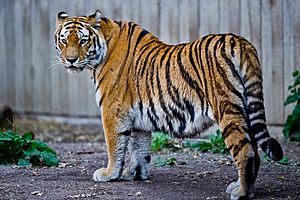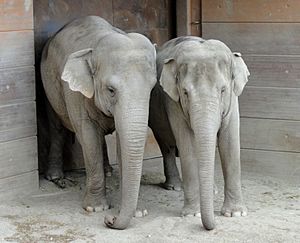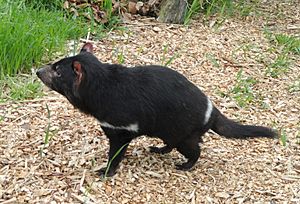Copenhagen Zoo facts for kids

Main entrance
|
|
| Date opened | 1859 |
|---|---|
| Location | Copenhagen, Denmark |
| Land area | 11 hectares (27 acres) |
| Coordinates | 55°40′22″N 12°31′17″E / 55.67278°N 12.52139°E |
| No. of animals | 3000+ |
| No. of species | 264 |
| Annual visitors | 1,161,388 (2008) |
| Memberships | EAZA, WAZA |
Copenhagen Zoo (also known as København Zoo in Danish) is a fun place to visit in Copenhagen, Denmark. It is one of the oldest zoos in Europe, first opening its doors in 1859.
The zoo covers about 11 hectares (that's like 27 acres!). It is located between two beautiful parks, Frederiksberg Gardens and Søndermarken. Many people love visiting Copenhagen Zoo. In 2008, over a million visitors came, making it the most popular zoo in Denmark. The zoo is famous for its amazing Elephant House, designed by the well-known architect Sir Norman Foster. Copenhagen Zoo also works hard to protect animals through special breeding programs.
Contents
History of Copenhagen Zoo
Copenhagen Zoo was started in 1859 by a bird expert named Niels Kjærbølling. He was given a lovely summer garden to create the zoo. When it first opened, visitors could see animals like eagles, chickens, ducks, owls, rabbits, a fox, a seal, and a turtle.
In the beginning, the zoo tried to have as many different kinds of animals as possible. But over time, people realized that animal comfort was very important. So, the zoo started giving more space to each animal, even if it meant having fewer different species. One amazing animal that lived here was a slow worm. It lived for 54 years, from 1892 to 1946! This is a record for lizards.
Since the 1980s, Copenhagen Zoo has been making big changes. They are replacing old cages with new areas that look like the animals' natural homes. This helps the animals live better and gives visitors a more realistic experience. The new Elephant House and the Savanna area are great examples of these improvements. The Savanna even has a special Hippopotamus House where you can watch hippos swim underwater!
The zoo has also kept many of its old buildings. The oldest building, built in 1872, was once a stable for yaks. Today, it is home to the bactrian camels. An old building from 1875 still houses plant-eating animals like tapirs. There is also an owl tower from 1885. It stands as a reminder of how zoos used to keep animals a long time ago.
Copenhagen Zoo Tower
A very tall wooden tower is a famous landmark at the zoo. It is 43.5 meters (about 143 feet) high. From the top, you can see amazing views of the zoo, nearby parks, and the city. The tower was built in 1905. It is one of the tallest wooden observation towers in the world. Its base looks a bit like the famous Eiffel Tower.
Amazing Animal Exhibits
Copenhagen Zoo has many different animals to see. Some animals not in specific themed areas include bactrian camels, bright American flamingos, scarlet ibises, and roseate spoonbills. You can also spot Dalmatian pelicans, turkey vultures, Humboldt penguins, and playful California sea lions. Other animals include black-capped squirrel monkeys, chimpanzees, and powerful lions.
The Nordics and the Arctic Ring
In the "Nordics" area, you can see animals from northern parts of the world. These include harbour seals, snowy owls, reindeer, musk oxen, and brown bears. You might also spot arctic foxes and grey wolves. The "Arctic Ring" opened in 2013. It has a special home for polar bears, where you can watch them swim through an underwater tunnel! There is also a bird area for seabirds from the North Atlantic.
Animals from Asia
In the "Asia" section, you can discover animals like Oriental small-clawed otters and cute red pandas. There are also Malayan tapirs, rare amur leopards, and huge siberian tigers. Of course, you'll also find the impressive Asian elephants here.
The new Elephant House opened in 2008. It was designed by famous architect Norman Foster. This amazing building has two glass-domed areas. One is for female elephants and their babies, and it's quite large. The other is for male elephants, who are kept separate during mating season to prevent fights.
The building also has a special area for visitors to learn and a small lecture hall. Outside, the elephants have a huge outdoor space almost 1 hectare big. It includes a deep pool where they can swim and play. The wall between the zoo and Frederiksberg Gardens was opened up. Now, people in the park can watch the elephants, too! This helps the zoo feel more connected to the city. It also gives the elephants a view of the open parkland, making them feel less enclosed.
African Savanna Animals
Most of the "Africa" section is a large "Savanna" area. This is an open field with a bridge for visitors to walk over. Here, you can see animals like white rhinoceroses, tall giraffes, and speedy impalas. You might also spot sable antelopes, ostriches, and plains zebras. The hippopotamuses have their own area but can also visit the Savanna. Other African animals in this section include okapis, Abyssinian ground hornbills, Congo peafowl, caracals, and playful meerkats.
Tasmania's Unique Animals
The "Tasmania" section is very special to Copenhagen Zoo. It started in 2004 when the government of Tasmania gave four Tasmanian Devils to the zoo. This was a gift after the wedding of Denmark's Crown Prince Frederik to Mary Donaldson, who is from Tasmania. These were the first Tasmanian devils to live outside of Australia!
This area has grown to include a shared space for red-necked wallabies, Eastern Grey Kangaroos, and common wombats. Parts of this area are open, so visitors can walk among the kangaroos!
South American Wildlife
In the "South America" section, you can see animals like capybaras (the world's largest rodents), guanacos, and large greater rheas. You might also spot Patagonian maras, southern screamers, and amazing giant anteaters. All these animals share a common area designed to look like the South American pampas (grasslands).
Tropical Zoo Adventure
The "Tropical Zoo" is like walking into a rainforest! It has a large hall where birds, turtles, and two-toed sloths roam freely. Another part of the hall is home to colorful tropical butterflies and nile crocodiles. In between these areas, you can find reptiles, amphibians, fish, and the very rare java mouse-deer.
Children's Zoo Fun
The Children's Zoo is a great place for younger visitors. Here, you can meet friendly farm animals and small domestic animals. These include llamas, goats, cows, pigs, horses, chickens, and rabbits.
Rare Species at the Zoo
- For many years, Copenhagen Zoo was the only zoo outside Australia that had Tasmanian devils. It is still the only zoo in Europe to have them. In 2013, the Tasmanian devils at the zoo had babies for the first time, with seven young born!
- Copenhagen Zoo is also home to other rare animals like the Amur leopard, okapi, and muskox.
Images for kids
-
A grey crowned crane (Balearica regulorumin)
-
Asian elephants (Elephas maximus) in the grounds of the new Elephant House
-
A hamadryas baboon (Papio hamadryas)
-
A hippo (Hippopotamus amphibius) yawning
See also
 In Spanish: Zoológico de Copenhague para niños
In Spanish: Zoológico de Copenhague para niños


